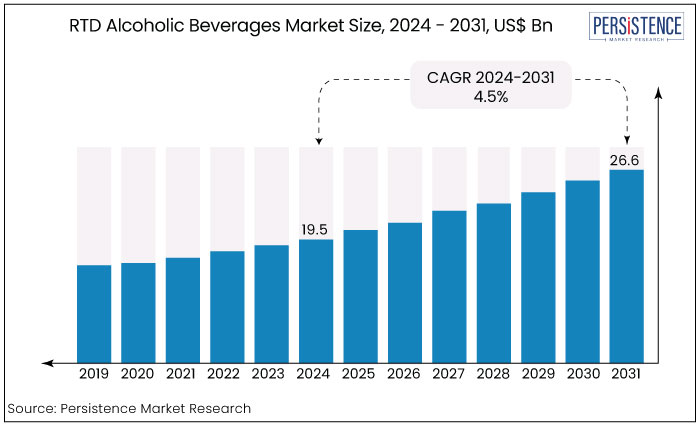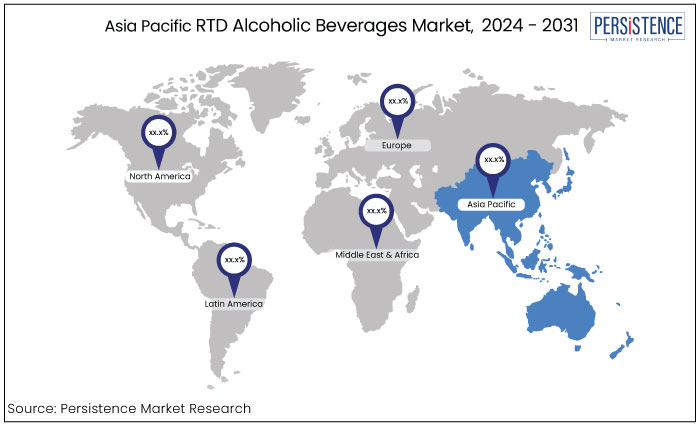Industry: Food and Beverages
Published Date: March-2025
Format: PPT*, PDF, EXCEL
Delivery Timelines: Contact Sales
Number of Pages: 185
Report ID: PMRREP31198
The RTD alcoholic beverages market is estimated to increase from US$ 20.3 Bn in 2025 to US$ 28.2 Bn by 2032. The market is projected to record a CAGR of 4.8% during the forecast period from 2025 to 2032. The industry is gaining popularity due to its convenience and versatility catering to various tastes and preferences.

Key Highlights of the Markets
|
Market Attributes |
Key Insights |
|
RTD Alcoholic Beverages Market Size (2025E) |
US$ 20.3 Bn |
|
Projected Market Value (2032F) |
US$ 28.2 Bn |
|
Global Market Growth Rate (CAGR 2025 to 2032) |
4.8% |
|
Historical Market Growth Rate (CAGR 2019 to 2024) |
6.5% |
Asia Pacific is expected to command a substantial share of the RTD alcoholic beverages market driven by rising consumer incomes and a growing number of working women in countries such as China, India, Indonesia, and Japan. This demographic shift enhances purchasing power and influences consumption patterns leading to increased demand for convenient beverage options.
There is a noticeable trend among consumers toward healthy lifestyles prompting adults to explore and experiment with new beverage products. This combination of factors is propelling the sales of ready-to-drink beverages across the region.
As consumers seek innovative and healthy alternatives, Asia Pacific market is expected to continue its robust growth trajectory reflecting evolving preferences and lifestyle choices.

In North America, the demand for ready-to-drink (RTD) beverages is predicted to grow substantially as consumer acceptance of these products continues to rise.
The COVID-19 pandemic has heightened awareness around health and wellness prompting individuals to prioritize their immunity and overall well-being. As a result, this is an increasing inclination toward fortified beverages that promote gut health including kombucha, energy drinks, and functional water.
Manufacturers are actively launching innovative products within these categories. A prime example is Reed's, Inc., which introduced Reed's Zero Sugar Stormy Mule in August 2022. This unique beverage crafted from ginger roots and rum, contains no added sugars, aligning perfectly with consumer preferences for healthy options.
The global market is segmented into fermented beverages, non-fermented beverages, and alcoholic beverages. Notably in 2024, the non-fermented beverages segment is expected to dominate the market driven by a wide availability of diverse options such as carbonated soft drinks, energy drinks, and fruit juices. Segment growth is largely attributed to evolving consumer preferences leaning toward healthy alternatives.
Companies are increasingly pivoting toward developing products that align with these preferences, as evidenced by Coca-Cola Company's 11% sales increase in Coca-Cola Zero Sugar during Q3 2022. As manufacturers intensify their focus on innovative offerings that incorporate functional ingredients, botanicals, and herbs aimed at enhancing immunity and overall health, this trend will present significant opportunities for growth within the industry.
The market for RTD alcoholic beverages is segmented into supermarkets/hypermarkets, specialty stores, convenience stores, online retail, and on premise outlets based on distribution channel. The supermarkets and hypermarkets segment is anticipated to capture a significant share of the global market driven by their growing popularity among consumers.
Large retail spaces offer a diverse array of products from various brands enhancing consumer choice and convenience. The ongoing expansion of supermarkets in different regions is expected to boost the segment growth. For instance,
Ready-to-drink (RTD) alcoholic beverages are pre-mixed drinks that combine alcohol with various flavors, juices, or mixers, making them convenient for consumers seeking quick and portable drinking options. Typically packaged in cans or bottles, RTD beverages cater to various tastes and preferences from cocktails to flavored spirits.
Key RTD alcoholic beverages market trends include the rise of health-conscious options, with brands introducing lower-calorie and organic ingredients. Moreover, the demand for craft-inspired beverages surges as consumers seek unique and artisanal flavors.
The influence of social media is also notable with visually appealing packaging and creative marketing strategies resonating with younger audiences. Expanding e-commerce platforms makes these products more accessible further propelling market growth. The RTD segment is evolving significantly, shifting toward innovative, ready-to-enjoy drinking experiences.
The RTD alcoholic beverages market has shown remarkable growth over the past decade driven by changing consumer preferences and a shift toward convenience. From 2019 to 2024, the market g expanded significantly, reflecting a CAGR of about 6.5% during this period.
The market operates by leveraging the popularity of cocktails and flavored drinks simplifying the consumption experience without mixing or preparation. This upward trajectory is expected to continue, with projections indicating a potential CAGR of 4.8% during the period from 2025 to 2032. The course ahead is characterized by innovation in flavors and packaging, alongside an increasing focus on health-conscious options.
As consumer demand for convenience and variety persists, the RTD segment is poised for sustained expansion, reshaping the landscape of the alcoholic beverage industry. This demand creates several RTD alcoholic beverages market opportunities for growth. The growth of the RTD segment is also driven by factors such as busy lifestyles, social gatherings, and the rising trend of home consumption of alcoholic beverages.
Increasing Demand for Convenience and Portability
One of the primary growth drivers for the RTD alcoholic beverages market expansion is the increasing demand for convenience and portability. With busy lifestyles and a culture of on-the-go consumption, consumers are seeking ready-to-drink options that require no preparation.
RTD beverages cater to this need by providing a quick and accessible way to enjoy cocktails and mixed drinks without the hassle of mixing ingredients. This convenience is particularly appealing to millennials and Gen Z consumers, who prioritize ease of use in their purchasing decisions.
The compact packaging of RTD drinks makes them ideal for social gatherings, outdoor events, and casual get-togethers further driving their popularity in a fast-paced world.
Increasing Emphasis on Health and Wellness among Consumers
The growing emphasis on health and wellness among consumers is significantly boosting the RTD alcoholic beverages market. As individuals become more health-conscious, there is a rising demand for products that offer lower calorie counts, reduced sugar content, and organic ingredients.
Brands are responding by developing healthier RTD options, such as hard seltzers and low-alcohol beverages that appeal to this demographic. This trend not only attracts health-focused consumers but also encourages traditional drinkers to explore lighter alternatives.
The incorporation of natural flavors and functional ingredients such as antioxidants and vitamins further enhances the appeal of these beverages. As health-conscious choices continue to gain traction, the RTD market is likely to see sustained growth driven by this segment.
Innovation in flavor profiles is a significant driver for the RTD alcoholic beverages market growth as brands strive to differentiate themselves in a competitive landscape. Consumers are increasingly seeking unique and diverse flavors that cater to their adventurous palates, moving beyond traditional offerings. This trend has led to the emergence of creative combinations, such as exotic fruit infusions, spicy blends, and craft-style cocktails, appealing to a wide range of taste preferences.
The rise of craft RTD beverages, often inspired by artisanal techniques and local ingredients, enhances this trend further. By continuously introducing innovative flavors, brands can attract new consumers and retain existing ones fueling market growth and encouraging exploration within the RTD category.
Complex Regulatory Environment Surrounding Alcohol Production and Distribution
One significant factor impeding RTD alcoholic beverages market is the complex regulatory environment surrounding alcohol production and distribution. Various federal and state regulations, enforced by agencies like the Alcohol and Tobacco Tax and Trade Bureau (TTB) and the Food and Drug Administration (FDA) impose strict guidelines on labeling, advertising, and ingredient disclosure.
Regulations can create barriers for new entrants and complicate compliance for existing brands, potentially stifling innovation and limiting market expansion. As companies navigate these regulatory hurdles, the associated costs and complexities can hinder growth opportunities in the RTD segment.
Health Concerns and Social Stigma
Another factor affecting the RTD alcoholic beverages market growth is the growing awareness of health concerns related to alcohol consumption. Increasing public health campaigns and research highlighting the risks of excessive drinking have led to a more cautious approach among consumers.
This shift in perception can create a social stigma around alcohol consumption, particularly among younger demographics who prioritize wellness and healthy lifestyles. As a result, some consumers may opt for non-alcoholic alternatives or limit their alcohol intake, which could impede the market growth as brands struggle to appeal to this health-conscious audience.
Rise of Health-Conscious Offerings
One significant future opportunity for the RTD alcoholic beverages market expansion lies in the expansion of health-conscious offerings. As consumers increasingly prioritize wellness and healthier lifestyles, brands can tap into this trend by developing products that feature lower calories, reduced sugar, and natural ingredients.
The introduction of hard seltzers, low-alcohol beverages, and organic RTD options can cater to health-focused consumers seeking guilt-free indulgence. Additionally, incorporating functional ingredients such as vitamins and antioxidants into RTD drinks can further enhance their appeal.
By aligning product development with health trends and promoting these innovations effectively, brands can capture a broad audience and foster brand loyalty, ultimately driving growth in a competitive market.
Rise of E-commerce and Digital Marketing
The rise of e-commerce presents a significant opportunity for the RTD alcoholic beverages market to expand its reach and enhance consumer engagement. As online shopping becomes increasingly popular particularly post-pandemic, brands can harness digital platforms to offer a seamless purchasing experience.
By investing in user friendly websites and partnering with e-commerce retailers, companies can make their products more accessible to consumers who prefer shopping from home. Furthermore, leveraging social media and digital marketing strategies can help brands effectively engage with their target audience, promote new products, and build brand loyalty. Interactive content, influencer partnerships, and targeted advertising can enhance visibility and drive sales positioning RTD brands for success in a rapidly evolving retail landscape.
The competitive landscape of the RTD alcoholic beverages market is marked by significant innovation and differentiation among leading brands. Leading players like Diageo have expanded their offerings with the launch of "Smirnoff Seltzer," featuring unique flavor combinations like "Pineapple" and "Dragonfruit" since 2022.
Similarly, Boston Beer Company introduced "Truly Extra Hard Seltzer," which boasts a higher alcohol content and bold flavors, catering to evolving consumer preferences. These innovations highlight the industry's focus on flavor diversity and health-conscious options, enabling brands to capture market share and respond to the growing demand for convenient, ready-to-drink alcoholic beverages.
Recent Developments in the RTD Alcoholic Beverages Market
|
Attributes |
Details |
|
Forecast Period |
2025 to 2032 |
|
Historical Data Available for |
2019 to 2024 |
| Market Analysis Units | Value: US$ Bn/Mn, Volume: As applicable |
|
Key Regions Covered |
|
| Report Highlights |
|
|
Key Companies Profiled |
|
|
Report Coverage |
|
|
Customization & Pricing |
Available upon request |
By Product Type
By Distribution Channel
By Region
To know more about delivery timeline for this report Contact Sales

The market is expected to reach US$ 28.2 billion by 2032.
The market is projected to grow at a CAGR of 4.8% during this period.
Asia Pacific is expected to lead, driven by rising consumer incomes and an increasing number of working women.
Convenience, portability, health-conscious trends, innovative flavors, and increasing disposable incomes.